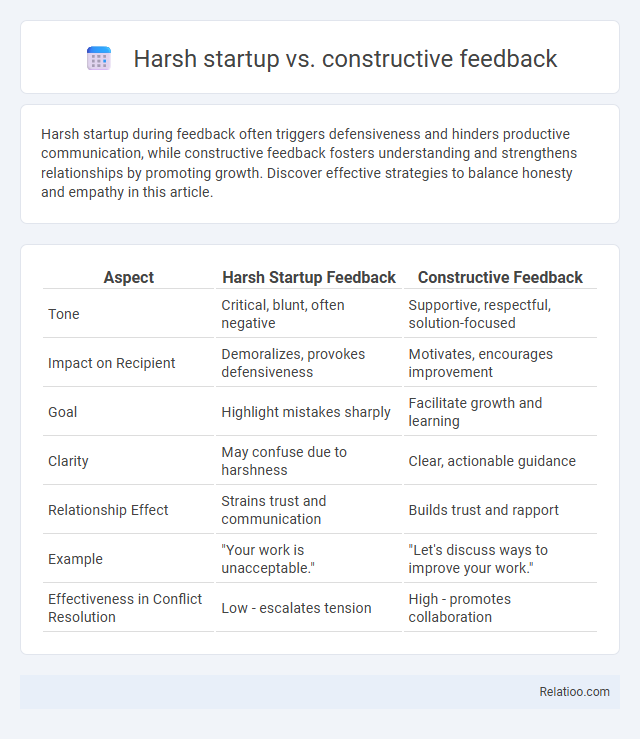Harsh startup during feedback often triggers defensiveness and hinders productive communication, while constructive feedback fosters understanding and strengthens relationships by promoting growth. Discover effective strategies to balance honesty and empathy in this article.
Table of Comparison
| Aspect | Harsh Startup Feedback | Constructive Feedback |
|---|---|---|
| Tone | Critical, blunt, often negative | Supportive, respectful, solution-focused |
| Impact on Recipient | Demoralizes, provokes defensiveness | Motivates, encourages improvement |
| Goal | Highlight mistakes sharply | Facilitate growth and learning |
| Clarity | May confuse due to harshness | Clear, actionable guidance |
| Relationship Effect | Strains trust and communication | Builds trust and rapport |
| Example | "Your work is unacceptable." | "Let's discuss ways to improve your work." |
| Effectiveness in Conflict Resolution | Low - escalates tension | High - promotes collaboration |
Understanding Harsh Startup and Constructive Feedback
Understanding harsh startup involves recognizing abrupt or overly critical remarks that can demotivate your team, while constructive feedback aims to provide clear, actionable suggestions that promote growth and improvement. Providing constructive feedback encourages open communication and supports your team's development, fostering a positive work environment. Balancing these approaches helps you maintain productivity and morale by addressing issues effectively without discouraging your colleagues.
The Psychology Behind Communication Styles
Harsh startup in communication often triggers defensive responses and increases emotional stress due to its confrontational tone, whereas constructive feedback promotes a growth mindset by focusing on specific behaviors and actionable improvements. Psychological research highlights that individuals receiving constructive feedback experience greater motivation and engagement, as it aligns with principles of positive reinforcement and cognitive appraisal. Understanding these communication styles is crucial for fostering effective interpersonal relationships and enhancing team dynamics in both personal and professional contexts.
Key Differences Between Harsh Startup and Constructive Feedback
Harsh startup involves delivering feedback with a negative or critical tone that may provoke defensiveness, while constructive feedback focuses on providing clear, specific, and actionable suggestions to foster improvement. The key difference lies in the intent and delivery: harsh startup often triggers emotional resistance, whereas constructive feedback encourages open dialogue and growth. Effective communication relies on framing criticism in a way that motivates change without damaging relationships or morale.
The Impact of Harsh Startup on Relationships
Harsh startup in conversations involves beginning interactions with criticism or hostility, often leading to defensiveness and emotional distance in relationships. Constructive feedback, in contrast, fosters open communication and mutual understanding by focusing on specific behaviors and offering solutions without blame. Your ability to recognize and avoid harsh startups can significantly improve relationship dynamics and promote healthier, more productive exchanges.
Benefits of Using Constructive Feedback
Constructive feedback fosters a growth mindset by providing specific, actionable insights that help you improve skills and performance without causing defensiveness or discouragement. Unlike harsh startup criticism, constructive feedback builds trust and motivates positive change, enhancing team collaboration and productivity. Using this approach, your startup can cultivate a culture of continuous learning and innovation, essential for long-term success.
Identifying Harsh Startup Triggers
Identifying harsh startup triggers involves recognizing emotional reactions, miscommunication, and defensiveness that escalate conflicts quickly. Constructive feedback contrasts by promoting clear, empathetic dialogue aimed at growth and problem-solving without triggering negative responses. Understanding these triggers helps prevent misunderstandings and fosters productive conversations in professional and personal settings.
Effective Techniques for Delivering Constructive Feedback
Effective techniques for delivering constructive feedback emphasize clarity, specificity, and empathy, avoiding the pitfalls of harsh startup that can trigger defensiveness and hinder growth. Using balanced language, focusing on behaviors rather than personal traits, and providing actionable suggestions create a supportive environment that fosters improvement and motivation. Prioritizing respectful communication and active listening enhances receptivity and strengthens professional relationships.
Common Mistakes to Avoid in Difficult Conversations
Harsh startup often triggers defensiveness by beginning conversations with blame or criticism, while constructive feedback focuses on specific behaviors and solutions, promoting a collaborative atmosphere. Common mistakes to avoid in difficult conversations include using accusatory language, interrupting, and neglecting to listen actively, which can escalate conflict and diminish trust. Your approach should emphasize clarity, empathy, and timing to foster understanding and positive outcomes.
Transforming Harsh Startup into Constructive Dialogue
Transforming harsh startup into constructive dialogue requires recognizing that your initial tone sets the foundation for effective communication, influencing openness and collaboration. By replacing abrupt or critical remarks with clear, solution-focused language, you foster a more positive environment that encourages feedback receptivity and problem-solving. This shift not only reduces defensiveness but also enhances mutual understanding, enabling teams to leverage feedback for continuous improvement.
Fostering a Positive Communication Culture
Fostering a positive communication culture involves balancing the directness of a harsh startup approach with the empathy found in constructive feedback, ensuring your team feels respected and motivated. You can encourage open dialogue by addressing issues candidly while offering actionable solutions that promote growth and collaboration. This blend reduces defensiveness and cultivates an environment where feedback drives improvement rather than conflict.

Infographic: Harsh startup vs Constructive feedback
 relatioo.com
relatioo.com